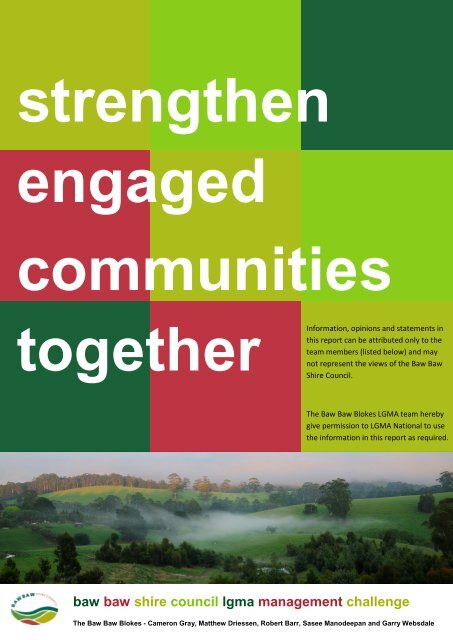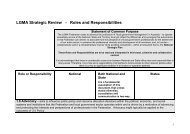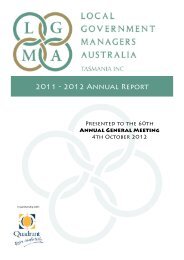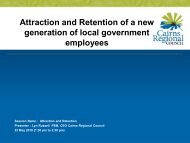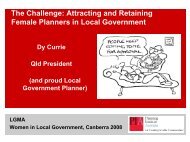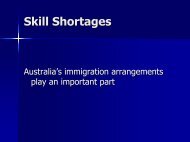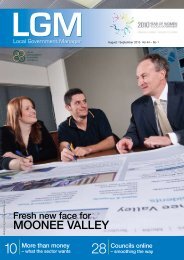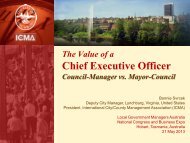Baw Baw Shire Council, VIC - Local Government Managers Australia
Baw Baw Shire Council, VIC - Local Government Managers Australia
Baw Baw Shire Council, VIC - Local Government Managers Australia
You also want an ePaper? Increase the reach of your titles
YUMPU automatically turns print PDFs into web optimized ePapers that Google loves.
strengthen<br />
engaged<br />
communities<br />
together<br />
Information, opinions and statements in<br />
this report can be attributed only to the<br />
team members (listed below) and may<br />
not represent the views of the <strong>Baw</strong> <strong>Baw</strong><br />
<strong>Shire</strong> <strong>Council</strong>.<br />
The <strong>Baw</strong> <strong>Baw</strong> Blokes LGMA team hereby<br />
give permission to LGMA National to use<br />
the information in this report as required.<br />
baw baw shire council lgma management challenge<br />
The <strong>Baw</strong> <strong>Baw</strong> Blokes - Cameron Gray, Matthew Driessen, Robert Barr, Sasee Manodeepan and Garry Websdale
section one - understanding the baw baw community<br />
a) about baw baw shire<br />
<strong>Baw</strong> <strong>Baw</strong> <strong>Shire</strong> is approximately 100 kilometres east of Melbourne in the heart of West Gippsland. It has an area of<br />
4,027 square kilometres and was formed in 1994 from the amalgamation of the former Buln Buln and Narracan<br />
<strong>Shire</strong>s, the Rural City of Warragul (previously the <strong>Shire</strong> of Warragul), and some parts of the <strong>Shire</strong> of Upper Yarra.<br />
The northern half of the shire is heavily forested and lies in the Great Dividing Range and its foothills, including parts<br />
of the Mt <strong>Baw</strong> <strong>Baw</strong> National Park, while the shire is bounded by the Strzelecki Range and its foothills to the south. The<br />
„middle‟ part of the shire is more densely populated, particularly in areas close to the Princes Highway and the<br />
Gippsland railway line, but still retains its rural environment. <strong>Baw</strong> <strong>Baw</strong> is bordered by South Gippsland, Cardinia, Yarra<br />
Ranges, Mansfield <strong>Shire</strong>, Wellington <strong>Shire</strong>, and Latrobe City.<br />
As the suburbs situated along the periphery of Melbourne have become more densely populated, the population in the<br />
towns of Warragul and Drouin are rising steeply. From 2006 to 2011, <strong>Baw</strong> <strong>Baw</strong> <strong>Shire</strong>'s population increased by 5,688<br />
people (15.3%). This represents an average annual population change of 2.89% per year over the period.<br />
Analysis of the demographic age groups of <strong>Baw</strong> <strong>Baw</strong> <strong>Shire</strong> in 2011 is similar when compared to Regional Victoria.<br />
Overall, 24.5% of the population was aged between 0 and 17, and 23.5% were aged 60 years and over, compared<br />
with 23.5% and 24.2% respectively for Regional Victoria.<br />
b) snapshots of baw baw shire<br />
population In 2011 was 44,042<br />
genders<br />
49% men and 51% women<br />
39 years (<strong>Australia</strong>: 37)<br />
median age<br />
Over 55 ~ 27.5%<br />
indigenous 0.9% (<strong>Australia</strong>: 2.3%)<br />
9.8% (<strong>Australia</strong>: 22.2%)<br />
born overseas<br />
Majority from UK, NZ and Europe<br />
Table 1: Snapshot statistical profile of <strong>Baw</strong> <strong>Baw</strong><br />
<strong>Baw</strong> <strong>Baw</strong> <strong>Shire</strong> is largely rural in nature, and is<br />
currently experiencing unprecedented residential<br />
expansion. The larger towns of Warragul (12,943),<br />
Drouin (7,523) and Trafalgar (2,684) sit alongside<br />
a handful of smaller towns with populations<br />
ranging from 597 to 1,600 and a sprinkling of<br />
smaller communities with a population below 500.<br />
2009/10 <strong>Australia</strong>n Bureau of Statistic (ABS) data<br />
indicates that <strong>Baw</strong> <strong>Baw</strong> <strong>Shire</strong> was the sixth (6th)<br />
fastest growing LGA in Victoria.<br />
The projected population of <strong>Baw</strong> <strong>Baw</strong> is expected to increase by 31.8% from the period 2011 to 2026 (as projected by<br />
DPCP - Victorian In Future). Below is the estimated population growth of residents in <strong>Baw</strong> <strong>Baw</strong> <strong>Shire</strong>. 1<br />
2011 2016 2021 2026 2031 Number Percentage<br />
Population 44,042 49,174 54,439 59,578 64,608 20,566 31.83<br />
The projected age structure sees a decline in persons 0 – 59 years generally (with the exception of the 25 – 34 year<br />
age group which is expected in increase slightly), and an increase in persons 60 years +. The largest increase is<br />
anticipated in the 70 – 84 year age group which is expected to increase by 1.95% during this period.<br />
In 2011, <strong>Baw</strong> <strong>Baw</strong> <strong>Shire</strong> had a higher median weekly household income than both Latrobe City and the Gippsland<br />
Region, however lower than the Victorian median. On average, individuals in <strong>Baw</strong> <strong>Baw</strong> receive $38 per week more<br />
than individuals in the Gippsland region, and $50 less than the state average.<br />
In 2011, a higher proportion of <strong>Baw</strong> <strong>Baw</strong> residents aged between 15 and 64 years were working full time compared to<br />
Latrobe and Gippsland residents of this age. <strong>Baw</strong> <strong>Baw</strong> had a lower proportion of people in this age group working full<br />
1 Central West Gippsland Primary Care Partnership
time compared to Victoria as a whole. <strong>Baw</strong> <strong>Baw</strong> had as many residents not in the labour force as were working full<br />
time, whilst the number of people not in the labour force was 1.2 times those employed full time in Latrobe LGA. .<br />
According to ABS 2011 Census data, the three industries with the highest proportion of population employed in <strong>Baw</strong><br />
<strong>Baw</strong> were: Health Care and Social Support, Construction and Retail. In 2011, <strong>Baw</strong> <strong>Baw</strong> had a significantly higher<br />
proportion of the population working in agriculture, than Latrobe and Victoria as a whole. This was also true of<br />
Gippsland as a whole. <strong>Baw</strong> <strong>Baw</strong> had 4 times the percentage of population working in agriculture, forestry and fishing<br />
compared to Latrobe and Victoria as a whole. 91% of homes in <strong>Baw</strong> <strong>Baw</strong> <strong>Shire</strong> <strong>Council</strong> have access to the internet,<br />
which is higher than the Victorian average.<br />
c) key shifts and changes in baw baw shire<br />
<strong>Baw</strong> <strong>Baw</strong> is currently experiencing a period of significant population growth which is expected to continue into<br />
the future. By 2026 there may be an additional 16,000 people living in the shire, and if this rate of growth<br />
continues, by 2050 there could be double our current population living in the municipality. The urbanisation<br />
puts pressure on the residents to pay more in rates and charges in order to keep up with the infrastructure<br />
needs of the community. Increase in developments increases pressure on the roads, drainage and<br />
environment which increases the need for maintenance.<br />
The aging profile of <strong>Baw</strong> <strong>Baw</strong> is resulting in increasing demand for services for the aged and access to<br />
services is becoming a significant issue for older residents in smaller townships and communities. <strong>Baw</strong> <strong>Baw</strong>‟s<br />
older population are increasingly socially isolated and there is a greater need on building connections for the<br />
community. In <strong>Baw</strong> <strong>Baw</strong> younger adults tend to leave the region for education and employment opportunities<br />
in the city and don‟t often return.<br />
The average household size is declining with more households without children and single person<br />
households. At present, there is an average of 1.7 people living in each household while at the same time<br />
houses are getting bigger. As a result of the increase in population and this trend for smaller households in<br />
bigger houses it is estimated an additional 1,000 hectares of land is needed by 2050.<br />
With such significant population growth expected, it is likely that there will be an impact on local amenity,<br />
character and lifestyle. The guidelines and local policies that are put into place over the next few years will<br />
determine whether the growth will be handled in a beneficial way.<br />
Regional township development within peri-urban regions sometimes replicates many of the problems of low<br />
density metropolitan sprawl. Most importantly, fragmentation can significantly reduce the land resources<br />
required for viable rural production.<br />
<strong>Baw</strong> <strong>Baw</strong> is becoming subject to the strong influence of Melbourne, accentuated by the excellent rail and road<br />
linkage, whilst having the attributes of a substantially rural municipality.<br />
section two - engagement<br />
d) introduction to engagement at baw baw shire council<br />
In 2008 <strong>Council</strong> established its Community Consultation and Engagement Framework with the aim to<br />
communicate a clear and consistent framework for community consultation and engagement and was<br />
based around the International Association for Public Participation‟s (IAP2) Spectrum of Public<br />
Participation. In 2012 it was identified that this framework mainly focused on informing and consulting the<br />
community and fell short in providing direction in regards to involving, collaborating and empowering the<br />
community to capture the full IAP2 spectrum.<br />
Current engagement work is extensive across the organisation and continues to grow each year on specific<br />
projects, activities and policies however there has not been any community engagement specifically about<br />
<strong>Council</strong>‟s community engagement processes.<br />
e) how we engage<br />
Using media releases and advertising.<br />
we inform by<br />
Contacting community through direct and indirect mail outs.<br />
Producing and providing newsletters
Broadcasting information online and via social media<br />
we consult by<br />
we involve by<br />
we collaborate by<br />
Requesting and receiving submissions and public comment.<br />
Providing opportunities to network with stakeholders.<br />
Hosting discussions and public forums/meetings.<br />
Producing and releasing surveys.<br />
Hosting workshops and forums<br />
Building consensus with networks and stakeholders<br />
Establishing advisory groups that provide recommendations to <strong>Council</strong><br />
we empower by<br />
Delegating to Section 86 committees to make decisions on behalf of <strong>Council</strong><br />
Table 2: <strong>Council</strong>s Current Engagement Methods and Techniques<br />
In 2011 <strong>Council</strong> engaged on 163 different topics and facilitated around 600 different engagement activities with more<br />
than 18,000 community members. Below are some examples of these engagements:<br />
who engages about what how they have engaged<br />
Growth and Development<br />
Planning Scheme Amendments<br />
Inform via media outlets and direct<br />
mail outs<br />
Settlement Strategy Implementation<br />
Inform via media outlets and direct<br />
mail outs. Consult by receiving<br />
submission and public comments.<br />
Community Care and Strengthening<br />
Community Services Planning<br />
Inform via newsletters and consult<br />
by receiving submissions.<br />
Municipal Public Health Plan<br />
Inform via media and mail outs.<br />
Consult by receiving submissions<br />
and public comment. Involve through<br />
the hosting of workshops and<br />
collaborate by building consensus<br />
with key stakeholders and networks.<br />
Corporate Service<br />
<strong>Council</strong>‟s Annual Budget<br />
Table 3: Examples of some <strong>Council</strong>s Community Engagement<br />
Inform via media outlets and consult<br />
at public meetings.<br />
f) engaging on baw baw community vision<br />
In 2010, <strong>Baw</strong> <strong>Baw</strong> <strong>Shire</strong> <strong>Council</strong> embarked on an extensive community consultation and engagement<br />
process involving 670 community members to identify and discuss issues facing the community, its future<br />
directions, values and visions. Resulting from this was the <strong>Baw</strong><strong>Baw</strong> 2050 Community Vision which<br />
identified a number of directions to achieve the <strong>Shire</strong>s future aspirations: managing growth; vibrant<br />
community living; lifelong learning; education; skills development and knowledge; valuing our environment;<br />
building responsible leadership and; building prosperity.<br />
As part of the <strong>Baw</strong><strong>Baw</strong> 2050 Community Vision project the following engagement methods were used:
we informed the<br />
community<br />
A public talk by futurist Dr. Peter Ellyard was held.<br />
Media articles and stories were published.<br />
Progress updates and reports distributed to the community.<br />
Community open days were hosted were the information gathered and the ideas<br />
shared was displayed for the community to view.<br />
we consult the<br />
community<br />
A photographic exhibition was held were participants were asked to provide a<br />
submission using photographic mediums.<br />
Surveys were produced, distributed and responses considered.<br />
Online and paper based submissions were received and considered.<br />
we involve the<br />
community<br />
Workshops were held with young people, <strong>Council</strong> staff, local indigenous community<br />
and small townships.<br />
we collaborate the<br />
community<br />
A futures conference was held were members of the community had direct input into<br />
the shaping of the community vision over two dedicated days.<br />
A community reference group was formed and referred to.<br />
Table 4: Community Engagement on the <strong>Baw</strong> <strong>Baw</strong> 2050 Community Vision Project<br />
g) comparing and assessing our engagement<br />
It has been identified that engagement is often adhoc and although often completed well, it is sometimes<br />
executed poorly. The <strong>Council</strong> has lacked a clear position as to when to engage, why engage and how to<br />
engage depending on the situation. It has also been identified that <strong>Council</strong>‟s internal engagement process‟<br />
lack clarity. Some members of <strong>Council</strong>‟s workforce are well skilled in engagement however majority of staff<br />
lack the skill set to engage effectively. There is also a strong negative opinion of <strong>Council</strong>‟s current<br />
engagement within the community.<br />
In comparing and assessing our engagement processes we have considered the following principles of<br />
best practise:<br />
1. Are the engagement processes based on an effective methodology?<br />
2. When engaging, do they use wide reaching, various and inclusive methods of engagement and are<br />
they using social media and online?<br />
3. Do they consider the effectiveness of the methods of engagement?<br />
4. Do they provide ongoing engagement training for staff?<br />
5. Have they engaged the community in a conversation about community engagement?
Our<br />
Engagement<br />
Other Organisations Engagment<br />
Organisation<br />
1.Based on<br />
methodology?<br />
2.Wide reaching,<br />
various and inclusive<br />
methods?<br />
3.Effectiveness<br />
considered?<br />
4.Engagement<br />
Training?<br />
5.Community<br />
engagement about<br />
community<br />
engagement?<br />
Latrobe City <strong>Council</strong><br />
(LCC)<br />
Yes, the IAP2 Spectrum<br />
of Public Participation.<br />
LCC consider this<br />
methodology best<br />
practice.<br />
Yes, LCC use variety of<br />
methods of<br />
engagement that met<br />
the community needs,<br />
including online and<br />
web based methods.<br />
Yes, LCC consider the<br />
effectiveness is<br />
considered in a matrix<br />
that identifies which<br />
methods are most<br />
effective for different<br />
situations.<br />
No. Ongoing training is<br />
not provided however<br />
in their Engagement<br />
Plan they have<br />
identified the need to<br />
provide targeted<br />
training and resources.<br />
Yes, the community<br />
were consulted in the<br />
production of the<br />
Engagement Plan.<br />
South Gippsland <strong>Shire</strong><br />
Yes the IAP2 Spectrum<br />
of Public Participation.<br />
Consider this<br />
methodology best<br />
practice.<br />
Yes, SGSC use a<br />
variety of methods of<br />
engagement that met<br />
the community needs,<br />
including online and<br />
web based methods.<br />
Yes, SGSC consider<br />
the effectiveness of the<br />
different methods and<br />
has specific methods<br />
for sub population<br />
groups eg. Youth<br />
engagement.<br />
Targeted training will<br />
be rolled out to key<br />
staff further training<br />
subject to <strong>Council</strong><br />
acceptance of draft<br />
document.<br />
No, council will review<br />
the draft plan and then<br />
further community<br />
consultation may be<br />
conducted.<br />
Cardinia <strong>Shire</strong> <strong>Council</strong><br />
Yes the IAP2 Spectrum<br />
of Public Participation.<br />
Yes, CSC has a<br />
considerable number<br />
of engagement<br />
methods including<br />
online.<br />
Yes, CSC has criteria<br />
for assessing the most<br />
effective methods for<br />
engagement and also<br />
consider evaluation at<br />
the planning stages.<br />
<strong>Council</strong> does not have<br />
funding for specific<br />
training however some<br />
in house training is<br />
proposed for key staff.<br />
No, council has not<br />
engaged the<br />
community in the<br />
development of their<br />
plan. This is under<br />
review.<br />
National <strong>Australia</strong> Bank<br />
No reference to IAP2<br />
method .<br />
An 8 step plan based<br />
on community<br />
participation. Targeted<br />
at employee health and<br />
well being.<br />
This method looks at<br />
statistics on outcomes<br />
where volunteering in<br />
the community<br />
improves health and<br />
profit.<br />
No specific training<br />
program.<br />
No specific procedure<br />
in place.<br />
<strong>Baw</strong> <strong>Baw</strong> <strong>Shire</strong> <strong>Council</strong><br />
Framework and<br />
processes based on<br />
IAP2. <strong>Council</strong><br />
considers IAP2 best<br />
practise<br />
<strong>Council</strong> has limited<br />
engagement methods<br />
in a framework or plan.<br />
Different methods are<br />
chosen adhoc by<br />
officers as they require.<br />
No formal framework<br />
for considering the<br />
effectiveness of the<br />
methods exists. Again<br />
this is considered on a<br />
adhoc basis.<br />
No formal engagement<br />
training is provided,<br />
however, extensive<br />
training is planned<br />
subject to council<br />
approval.<br />
<strong>Council</strong> has not<br />
engaged with the<br />
community about<br />
community<br />
engagement.<br />
Table 5: Comparing <strong>Council</strong>s engagement to other organisations.
h) engaging with social media and web 2.0<br />
Studies have shown that councils see the greatest value of social media is in promoting events and general<br />
community engagement 2 . The most popular method is using Facebook and Twitter to promote particular<br />
events and posting of high level news stories. This is mirrored in <strong>Baw</strong> <strong>Baw</strong> where recently Facebook was<br />
used to promote the Ficifolia Festival and Twitter was used to spread information about active bushfires.<br />
Conversely surveys of the community use of social media show that engaging with local government ranks<br />
very lowly on the reasons for using social media 3 . However, we consider there are opportunities for <strong>Baw</strong><br />
<strong>Baw</strong> <strong>Shire</strong> <strong>Council</strong> to improve and expand on the use of social media to enable better community<br />
engagement. The best source of online information remains the <strong>Baw</strong> <strong>Baw</strong> <strong>Shire</strong> <strong>Council</strong> website, and<br />
increased use of other social media outlets will help drive traffic to this site.<br />
i) increasing the conversation online<br />
Social media and web 2.0 allow the community and the <strong>Council</strong> to have a “conversation” however presently<br />
<strong>Council</strong>‟s use of social media is directed mostly one way and the tools are only being used to broadcast<br />
and inform the community. Social media presents opportunities to be more interactive, immediate and<br />
responsive and thus engage with community members at a time and in a space of their choosing and could<br />
extend the engagement to consulting, involving and collaborating.<br />
Recent research has shown all age groups use social media. As might be expected the frequency of use<br />
decreased with age. More than half (53%) found that social networking sites increased their contact with<br />
friends and family and increased their participation in social activities (26%). The increased social<br />
participation leads to an improvement in self-esteem and mental health and using this evidence <strong>Council</strong> is<br />
in the position to increase quality of life and wellbeing of the residents by promoting social participation<br />
online 4 .<br />
benefits social media presents<br />
Increased conversation and extension of engagement to<br />
consulting, involving and collaborating<br />
Opportunity to engage with the community in “their”<br />
space during “their time” for example the physically hard<br />
to reach, those with a disability or socially isolated.<br />
Not having to rely on journalistic interpretation.<br />
Disseminate a wide range of information effectively and<br />
efficiently and making cost savings<br />
barriers social media presents<br />
Lack of understanding and knowledge of the potential<br />
uses and benefits.<br />
The digital divide – the inequality between groups in<br />
terms of access to, use of, or knowledge of information<br />
and communication technologies.<br />
The fear of losing control over the message and<br />
conversation and the fear of damaging reputation.<br />
Additional cost and resources on <strong>Council</strong> to manage<br />
Social Media Engagement.<br />
Promoting a stronger sense of community and building<br />
positive resilience.<br />
The community are there already and the conversations<br />
are already happening.<br />
Learn what issues are important to the community<br />
Table 6: Identified benefits and barriers of social media 5<br />
2 ACELG<br />
3 Sensis 2011<br />
4 The Social and Psychological Impact of Online Social Networking APS National Psychology Week Survey 2010 – Mathews and Cameron<br />
5 Information identified from various sources including: Headspace; Howard, A.2012;
j) new possibilities in social media and web 2.0<br />
Web 2.0 presents the opportunity to create online space where community members could have a standalone<br />
online user accounts, similar to online banking, where all interactions with <strong>Council</strong> could occur online<br />
and the space could allow for user-controlled preferences. This opportunity would allow <strong>Council</strong> to engage<br />
in the space and manner the user defines as well as opportunities to directly broadcast to the community. A<br />
space like this could also allow community to pay bills, access information, report concerns, provide<br />
feedback and request services. It would also provide <strong>Council</strong> with a holistic snap shot of the user‟s<br />
interaction with <strong>Council</strong> to provide better customer service and engagement.<br />
Web 2.0 and social media also allows <strong>Council</strong> to better understand community perspective and the<br />
conversations that happen online can shape and inform policy and initiatives, making the community the<br />
initiators of change. The community are already having these conversations, web 2.0 and social media<br />
better allows <strong>Council</strong> to listen. The potential exists for <strong>Council</strong> to programmatically pick up and gather<br />
information from discussions, comments, conversations and broadcasts that are happening about <strong>Council</strong><br />
and our services and also build consultation and engagement specific web environments.<br />
section three community governance<br />
k) introduction to community governance at baw baw shire council<br />
At <strong>Baw</strong> <strong>Baw</strong> <strong>Shire</strong> <strong>Council</strong> community governance means sharing & collaboration between staff and<br />
community members or groups to develop plans for now and the future covering all aspects of <strong>Council</strong>‟s<br />
responsibilities. This could include all stages from planning to implementation and review.<br />
<strong>Council</strong> needs to ensure community governance is set up in a way that our many diverse communities are<br />
all represented when and where appropriate. <strong>Council</strong> and the communities need to have an understanding<br />
of the part they play in shaping the municipality, including infrastructure, services and programs.<br />
<strong>Council</strong>s systems need to have the ability to foster community governance and involvement particularly<br />
when issues arise.<br />
l) benefits of community governance for baw baw shire<br />
benefits for the organisation<br />
benefits for the community<br />
Opportunity to learn and get an in depth understanding of<br />
what the community wants and needs are for now and in<br />
the future. This will allow council to better plan for the<br />
future and understand and respond to the real issues<br />
Feeling that the council is not hiding decision from them<br />
and that council is communicating and listening to them<br />
Breaking down the silos within council to work with<br />
community groups as a whole rather than individually<br />
Ensuring all levels of local government not just<br />
councilors, CEO and senior management are involved<br />
with the community therefore all staff gain greater<br />
experience at working with different communities<br />
There is an incredible amount of knowledge and<br />
expertise in our diverse communities for council to utilise<br />
to further enhance any planning and decision making<br />
process<br />
If involved in a project from the planning stage then they<br />
will have more confidence and ownership in the<br />
proposed outcome<br />
By sharing the power of decisions it will empower the<br />
community to be more involved in further decisions that<br />
affect them<br />
They will feel a sense of pride, belonging and doing a<br />
good deed for where they live as they have helped to<br />
shape the way their communities are
Better service, infrastructure, economic value,<br />
environmental quality and enhancing communities<br />
wellbeing<br />
Solve issues proactively rather than waiting for the<br />
community to complain about it.<br />
They will learn about the different needs of other<br />
communities within the region and how to balance all of<br />
their needs fairly<br />
It ensures that all community members get a say not just<br />
the noisy ones<br />
Opportunity to solve complex issues by working with<br />
multiple communities<br />
This will bring individual communities together and find<br />
new ways to increase community spirit<br />
Table 7: benefits of community governance<br />
m) achieving community governance in baw baw shire<br />
<strong>Baw</strong> <strong>Baw</strong> <strong>Shire</strong> <strong>Council</strong> conducts many community planning activities and has an overarching Community<br />
Plan in „<strong>Baw</strong> <strong>Baw</strong> 2050‟. The <strong>Council</strong> planning process refers to and responds to the priorities in the plan.<br />
The <strong>Council</strong> Plan ends up being the commitment from the elected group to the community on what they are<br />
going to achieve in their four year term. There is a legislated community consultation process required<br />
before any <strong>Council</strong> Plan and Budget is endorsed by <strong>Council</strong> which gives the community a further<br />
opportunity to validate or query if the plan and the budget is meeting their needs and priorities.<br />
Formal delegation to the community also occur through a number of s86 committees. Each committee has<br />
been developed independently and as a response to specific community needs at that time.<br />
n) best practise in community governance<br />
Organisation and what they are<br />
doing to achieve community<br />
governance<br />
Manningham City <strong>Council</strong><br />
Created a Generation 2030 Community<br />
Plan which encompasses the needs and<br />
wishes of their community now and into the<br />
future (2030)<br />
Benalla Rural <strong>Council</strong><br />
Formed a Benalla & District Community<br />
Taskforce in response to a study that<br />
identified Benalla in the top 15% of the<br />
most socially disadvantaged postcodes in<br />
Victoria<br />
Good practice examples of achieving community<br />
governance<br />
Engaged with a large number of community members to create 20,000<br />
wishes for improvements to the community. Identified that there is a<br />
incredible wealth of knowledge and commitment that local residents<br />
want to share<br />
The completed plan will inform and guide the development of all future<br />
councils policies and strategies.<br />
The plan has four main stages: Understand our community, community<br />
vision, action planning and implementation and monitoring. These<br />
stages ensure that all aspects of community governance are adhered<br />
too and followed up on a continued basis.<br />
Involved more than 300 organsations including government and nongovernment<br />
agencies, service clubs, church‟s, philanthropic, business<br />
and other community groups. Involving such a broad section of the<br />
community ensure that a majority of the community are represented in<br />
the plan<br />
Focus action teams created to ensure they had specific tasks and<br />
targets to achieve to keep on track and monitor and review.<br />
Ensured consultation with the community groups as research enabled<br />
the collection of a wide range of information and data
Bendigo and Adelaide Bank<br />
Created a Generation 2030 Community<br />
Plan which encompasses the needs and<br />
wishes of their community now and into the<br />
future (2030)<br />
Centre for Aboriginal Economic Policy<br />
Research<br />
Investigated the nature of indigenous<br />
community governance to understand what<br />
works, what doesn‟t work and why and<br />
have formulated this into a report:<br />
Indigenous Community Governance<br />
Project 2005.<br />
Table 8: organisations achieving community governance 6<br />
Good networks and knowledge on what is happening within their<br />
communities<br />
The bank invests back into the community via their charitable arm,<br />
Community Enterprise Foundation. This has helped to create stronger<br />
and more sustainable communities which have a flow on affect<br />
creating more sustainable businesses.<br />
Listens to what the community‟s needs are and supporting them to<br />
realise these to increase economic stability for themselves and the<br />
community around them.<br />
The relationship between decision making in indigenous community<br />
governance is shaped by historical, cultural and political relationships.<br />
These need to be understood otherwise it will not work.<br />
There is no one size fits all approach to each community governance<br />
as individual community will respond to community governance<br />
differently and methods need to be changed to accommodate this.<br />
Leadership within each community can be a foundation stone for<br />
community governance to ensure that consensus, negotiation and<br />
consultation is followed by all involved.<br />
o) comparing community governance in baw baw shire to best practice<br />
Community Governance in practice in <strong>Baw</strong> <strong>Baw</strong> is a moveable feast. <strong>Council</strong> has adopted the IAP2<br />
framework yet continues to conduct practices that are adhoc, lack clarity and fail to reference to the<br />
overarching council plan. On the other hand there are many examples of good practice in community<br />
engagement and governance, the <strong>Baw</strong> <strong>Baw</strong> 2050 Plan is a prime demonstration of a job well done.<br />
However, the follow up to this good piece of work remains adhoc and is dependent on individual<br />
departments, or even individuals, understanding of the plan and the relevance to their particular goal.<br />
In conclusion it is important to note that <strong>Baw</strong> <strong>Baw</strong> <strong>Shire</strong> <strong>Council</strong> devotes a significant amounts of time,<br />
resources and importance on Community Governance. There are many and varied good practice examples<br />
both current and historic across the organisation. On the other hand <strong>Council</strong> is still trying to coordinate a<br />
structure that will be implemented across the organisation as a whole. As such overall analysis of<br />
Community Governance, and Community Engagement, in <strong>Baw</strong> <strong>Baw</strong> is difficult. The organisation is working<br />
towards adopting an overarching framework and it can be assumed that this in itself will improve outcomes<br />
for <strong>Council</strong> and the community of <strong>Baw</strong> <strong>Baw</strong>.<br />
In addition to the adoption of a holistic framework, it is considered that other actions could be implemented<br />
to improve practice across the <strong>Baw</strong> <strong>Baw</strong> <strong>Shire</strong>, these are outlined below.<br />
action plan<br />
Engagement Goal: <strong>Council</strong> aims to facilitate and partner with an actively engaged community, enabling<br />
quality change and progress for the <strong>Baw</strong> <strong>Baw</strong> area, working towards a shared vision and goals. Where the<br />
community and <strong>Council</strong> have a more holistic view of the numerous issues and demands on the <strong>Shire</strong>.<br />
6 Information identified from various sources including Manningham City <strong>Council</strong> – Generation 2030 Community Plan, Benalla<br />
&District Community Taskforce Annual Report 2010/11, Bendigo Bank– Community Bank, Sustainable Communities and Building<br />
Better Communitie, Centre for Aboriginal Economic Policy Research. ANU College of Arts & Social Sciences
1. Action Area: Have a consistent engagement processes and framework<br />
By the end of 2014 <strong>Council</strong> will have adopted a sound and robust community engagement process that will provide<br />
consistency and structure of all engagement across the organisation<br />
<strong>Council</strong> will conduct an internal review to ensure that staff understand the concepts of community engagement and<br />
governance. Furthermore, ask staff to reflect upon current practice and inform of all existing practice. Information<br />
gathered from this review will be incorporated into the draft framework and policy (based on IAP2).<br />
At this point <strong>Council</strong> will engage the community on the framework and policy and implement feedback and<br />
suggestions as appropriate, ensuring that we answer the key question “How do the community want to engage with<br />
<strong>Council</strong>?” Further consultation with the community on the framework will be completed before it is fully adopted.<br />
2. Action Area: Promote Community Engagement and Community Governance<br />
By the end of 2014 all of <strong>Council</strong>s services, programs and projects will reflect <strong>Council</strong>s overall goal to have an actively<br />
engaged <strong>Baw</strong> <strong>Baw</strong> community.<br />
Review and adapt all council policy and procedures to ensure all of <strong>Council</strong>s work has referenced the adopted<br />
community engagement framework.<br />
An annual review will be conducted, and report to council on the effectiveness of the engagement framework and<br />
ensure that the community‟s needs and wishes have become core to council business.<br />
3. Action Area: Provide staff training on community engagement<br />
By the end of 2015, 100% of <strong>Council</strong> staff will have received an appropriate level of training in engagement to<br />
understanding the importance and relevance of engagement to their work.<br />
Produce and conduct training that fosters understanding and knowledge of the community engagement framework.<br />
Ensuring an understanding of the importance of a holistic engagement process across all roles within the <strong>Council</strong>.<br />
Monitoring and evaluation systems will be established to ensure all staff receive appropriate level of training. This<br />
training will form part of the induction process for all new staff and will form part of <strong>Council</strong>s Code of Conduct and HR<br />
Policies.<br />
4. Action Area: Enter Web 2.0 and Reducing the Digital Divide<br />
By the end of 2016, 50% of <strong>Council</strong> interactions and services will be available online in an interactive and engaging<br />
space.<br />
<strong>Council</strong> will identify possible processes and technologies available and then engage the community on their wishes<br />
and priorities in this area. Alongside this, an internal organisational wide review will identify services that could be<br />
made available online. As a result of both consultations a GAP analysis will be conducted to identify where existing<br />
„out of the box‟ technology will not meet the identified needs.<br />
A training program will be developed for both internal staff and the community on any and all new processes. This<br />
may include developing opportunities for assisted online processing within customer service centres – For example<br />
kiosks similar to the self service check out areas in supermarkets, with staff on hand to guide customers.<br />
<strong>Council</strong> will expand on existing Social Media use and will use online portals to drive traffic to and from the different<br />
media pages. This is in effort to encourage a greater online conversation and therefore more informal engagement.<br />
It is expected that increased use of the Web 2.0 and Social Media technologies described above will highlight the<br />
digital divide. As such <strong>Council</strong> will implement requirements for all appropriate subdivisions to be NBN ready, provide<br />
targeted community computer and web training and promote community leadership and programs that aim to reduce<br />
this divide. Furthermore, <strong>Council</strong> will lobby state and federal government to provide funding to assist the above<br />
programs.<br />
In addition <strong>Council</strong> will continue to recognise that although digital solutions will continue to grow, it is important to<br />
retain the existing systems that the community recognise and request, such as face to face customer service centres.


